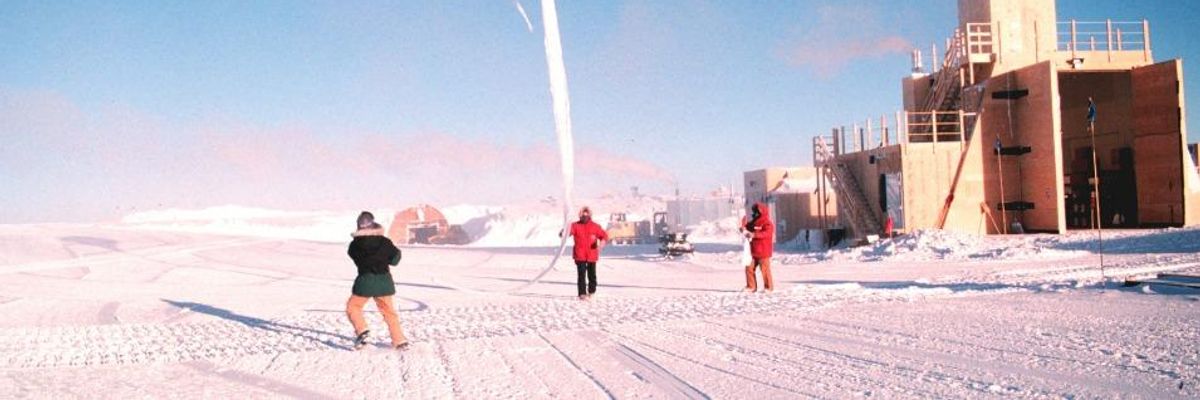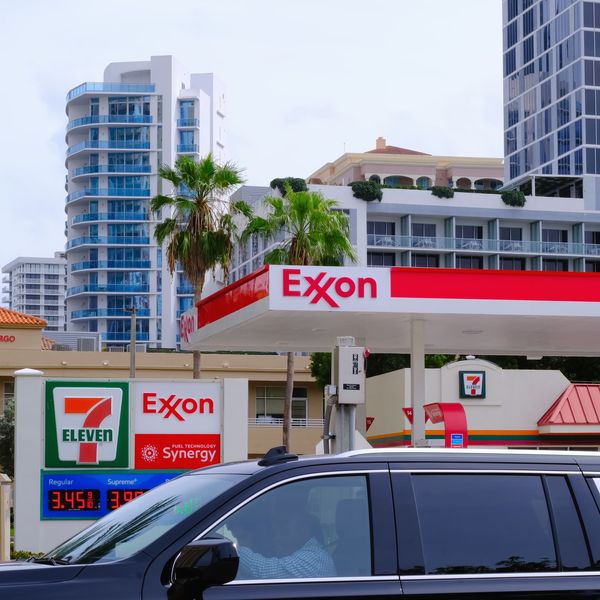
NOAA scientists launching an ozonesonde, a balloon-transported instrument used to measure a vertical profile of the ozone layer, at South Pole Station. (Photo: NOAA Photo Library/Flickr/cc)
'Somebody's Cheating': 8 Years After Ban, Scientists Urge World Leaders to Find Mysterious Source Behind Skyrocketing CFC Levels
"We're raising a flag to the global community to say, 'This is what's going on, and it is taking us away from timely recovery of the ozone layer.'"
Despite having been banned, emissions of a chemical found to create holes in the ozone layer have skyrocketed in recent years, according to a new study--leading scientists to wonder whether the pollutant is being secretly manufactured somewhere on Earth.
Scientists at the National Oceanic and Atmospheric Administration (NOAA) found that CFC-11 emissions have gone up 25 percent since 2012, although the international community agreed to end production of all chlorofluorocarbons (CFCs) by 2010 as part of the Montreal Protocol in 1987.
"Somebody's cheating," Durwood Zaelke, founder of the Institute for Governance and Sustainable Development, told the Washington Post of the new research. "There's some slight possibility there's an unintentional release, but...they make it clear there's strong evidence this is actually being produced."
The study, which was published in Nature on Wednesday, suggests that new production of the chemical is being carried out by an identified source in East Asia.
"It is therefore critical that we take stock of this science, identify the causes of these emissions, and take necessary action." --Keith Weller, U.N. Environment Program
The chemical was widely used in aerosol spray cans and as a foaming agent before being phased out under the Montreal Protocol, which was negotiated by the United Nations in 1987. Scientists had determined that CFC-11 could remain in the atmosphere for up to 50 years once it's released, causing chemical reactions that eat away at the ozone layer, and contributing to the warming of the Earth.
The ozone layer has been gradually recovering from its depletion, but NOAA reports that the newly-found CFC-11 emissions could slow the restoration of the vital layer of the stratosphere by about 22 percent.
"We're raising a flag to the global community to say, 'This is what's going on, and it is taking us away from timely recovery of the ozone layer,'" said NOAA scientist Stephen Montzka, in a statement. "Further work is needed to figure out exactly why emissions of CFC-11 are increasing, and if something can be done about it soon."
NOAA's findings are "environmentally and politically quite serious," former NASA scientist Robert Watson told the Post, stressing that international leaders who have signed on to the Montreal Protocol must address the study's revelation.
"It is not clear why any country would want to start to produce, and inadvertently release, CFC-11, when cost-effective substitutes have been available for a long while," Watson continued.
"If these emissions continue unabated, they have the potential to slow down the recovery of the ozone layer," Keith Weller, spokesman for the U.N. Environment Program said in a statement. "It is therefore critical that we take stock of this science, identify the causes of these emissions, and take necessary action."
An Urgent Message From Our Co-Founder
Dear Common Dreams reader, The U.S. is on a fast track to authoritarianism like nothing I've ever seen. Meanwhile, corporate news outlets are utterly capitulating to Trump, twisting their coverage to avoid drawing his ire while lining up to stuff cash in his pockets. That's why I believe that Common Dreams is doing the best and most consequential reporting that we've ever done. Our small but mighty team is a progressive reporting powerhouse, covering the news every day that the corporate media never will. Our mission has always been simple: To inform. To inspire. And to ignite change for the common good. Now here's the key piece that I want all our readers to understand: None of this would be possible without your financial support. That's not just some fundraising cliche. It's the absolute and literal truth. We don't accept corporate advertising and never will. We don't have a paywall because we don't think people should be blocked from critical news based on their ability to pay. Everything we do is funded by the donations of readers like you. Will you donate now to help power the nonprofit, independent reporting of Common Dreams? Thank you for being a vital member of our community. Together, we can keep independent journalism alive when it’s needed most. - Craig Brown, Co-founder |
Despite having been banned, emissions of a chemical found to create holes in the ozone layer have skyrocketed in recent years, according to a new study--leading scientists to wonder whether the pollutant is being secretly manufactured somewhere on Earth.
Scientists at the National Oceanic and Atmospheric Administration (NOAA) found that CFC-11 emissions have gone up 25 percent since 2012, although the international community agreed to end production of all chlorofluorocarbons (CFCs) by 2010 as part of the Montreal Protocol in 1987.
"Somebody's cheating," Durwood Zaelke, founder of the Institute for Governance and Sustainable Development, told the Washington Post of the new research. "There's some slight possibility there's an unintentional release, but...they make it clear there's strong evidence this is actually being produced."
The study, which was published in Nature on Wednesday, suggests that new production of the chemical is being carried out by an identified source in East Asia.
"It is therefore critical that we take stock of this science, identify the causes of these emissions, and take necessary action." --Keith Weller, U.N. Environment Program
The chemical was widely used in aerosol spray cans and as a foaming agent before being phased out under the Montreal Protocol, which was negotiated by the United Nations in 1987. Scientists had determined that CFC-11 could remain in the atmosphere for up to 50 years once it's released, causing chemical reactions that eat away at the ozone layer, and contributing to the warming of the Earth.
The ozone layer has been gradually recovering from its depletion, but NOAA reports that the newly-found CFC-11 emissions could slow the restoration of the vital layer of the stratosphere by about 22 percent.
"We're raising a flag to the global community to say, 'This is what's going on, and it is taking us away from timely recovery of the ozone layer,'" said NOAA scientist Stephen Montzka, in a statement. "Further work is needed to figure out exactly why emissions of CFC-11 are increasing, and if something can be done about it soon."
NOAA's findings are "environmentally and politically quite serious," former NASA scientist Robert Watson told the Post, stressing that international leaders who have signed on to the Montreal Protocol must address the study's revelation.
"It is not clear why any country would want to start to produce, and inadvertently release, CFC-11, when cost-effective substitutes have been available for a long while," Watson continued.
"If these emissions continue unabated, they have the potential to slow down the recovery of the ozone layer," Keith Weller, spokesman for the U.N. Environment Program said in a statement. "It is therefore critical that we take stock of this science, identify the causes of these emissions, and take necessary action."
Despite having been banned, emissions of a chemical found to create holes in the ozone layer have skyrocketed in recent years, according to a new study--leading scientists to wonder whether the pollutant is being secretly manufactured somewhere on Earth.
Scientists at the National Oceanic and Atmospheric Administration (NOAA) found that CFC-11 emissions have gone up 25 percent since 2012, although the international community agreed to end production of all chlorofluorocarbons (CFCs) by 2010 as part of the Montreal Protocol in 1987.
"Somebody's cheating," Durwood Zaelke, founder of the Institute for Governance and Sustainable Development, told the Washington Post of the new research. "There's some slight possibility there's an unintentional release, but...they make it clear there's strong evidence this is actually being produced."
The study, which was published in Nature on Wednesday, suggests that new production of the chemical is being carried out by an identified source in East Asia.
"It is therefore critical that we take stock of this science, identify the causes of these emissions, and take necessary action." --Keith Weller, U.N. Environment Program
The chemical was widely used in aerosol spray cans and as a foaming agent before being phased out under the Montreal Protocol, which was negotiated by the United Nations in 1987. Scientists had determined that CFC-11 could remain in the atmosphere for up to 50 years once it's released, causing chemical reactions that eat away at the ozone layer, and contributing to the warming of the Earth.
The ozone layer has been gradually recovering from its depletion, but NOAA reports that the newly-found CFC-11 emissions could slow the restoration of the vital layer of the stratosphere by about 22 percent.
"We're raising a flag to the global community to say, 'This is what's going on, and it is taking us away from timely recovery of the ozone layer,'" said NOAA scientist Stephen Montzka, in a statement. "Further work is needed to figure out exactly why emissions of CFC-11 are increasing, and if something can be done about it soon."
NOAA's findings are "environmentally and politically quite serious," former NASA scientist Robert Watson told the Post, stressing that international leaders who have signed on to the Montreal Protocol must address the study's revelation.
"It is not clear why any country would want to start to produce, and inadvertently release, CFC-11, when cost-effective substitutes have been available for a long while," Watson continued.
"If these emissions continue unabated, they have the potential to slow down the recovery of the ozone layer," Keith Weller, spokesman for the U.N. Environment Program said in a statement. "It is therefore critical that we take stock of this science, identify the causes of these emissions, and take necessary action."

